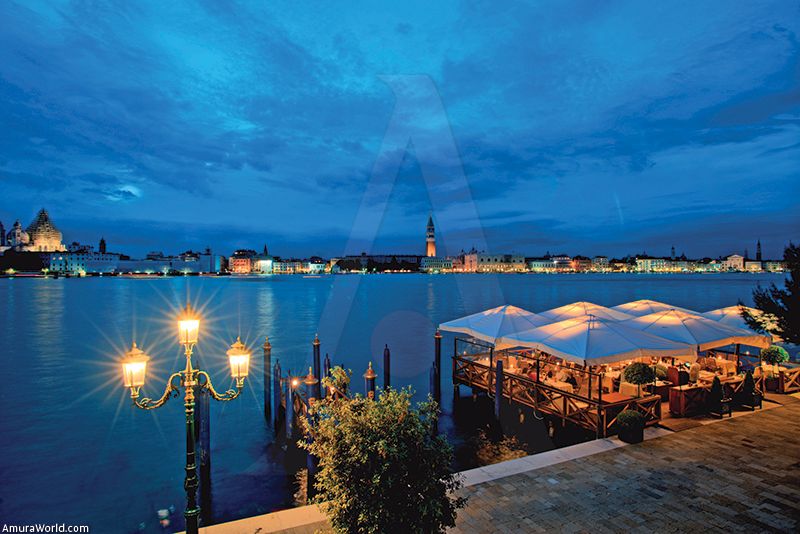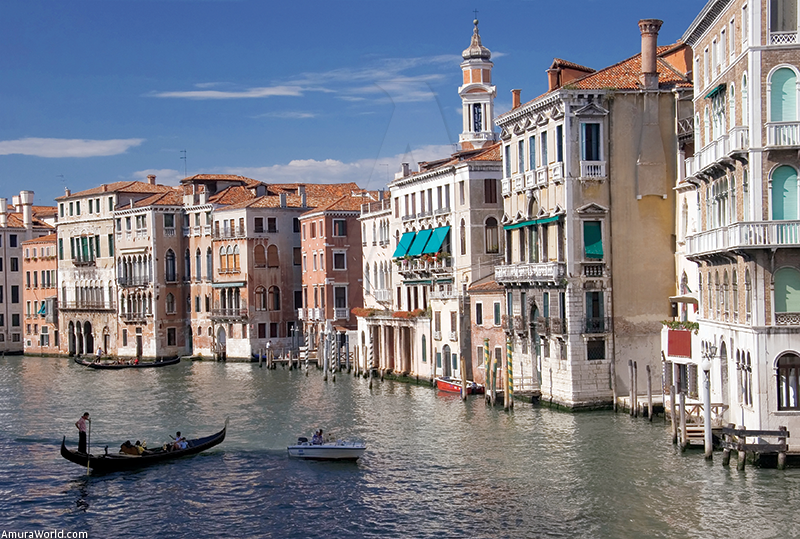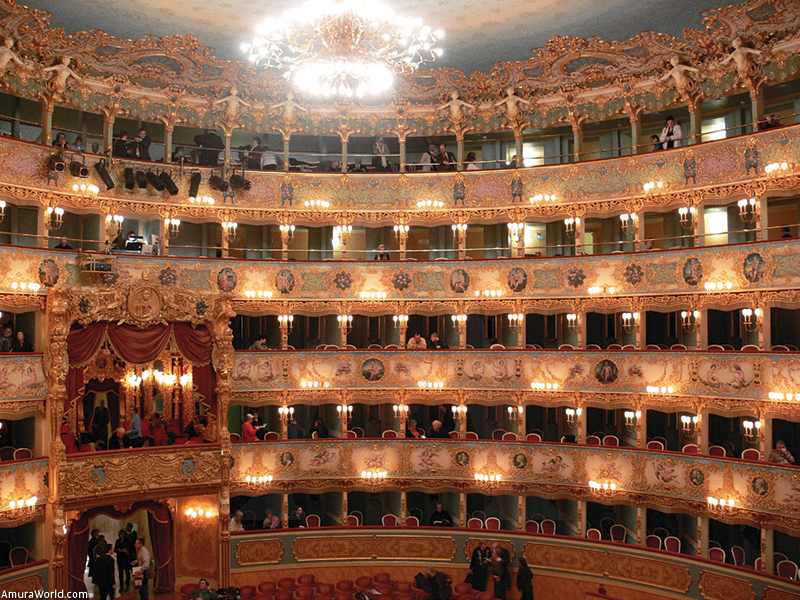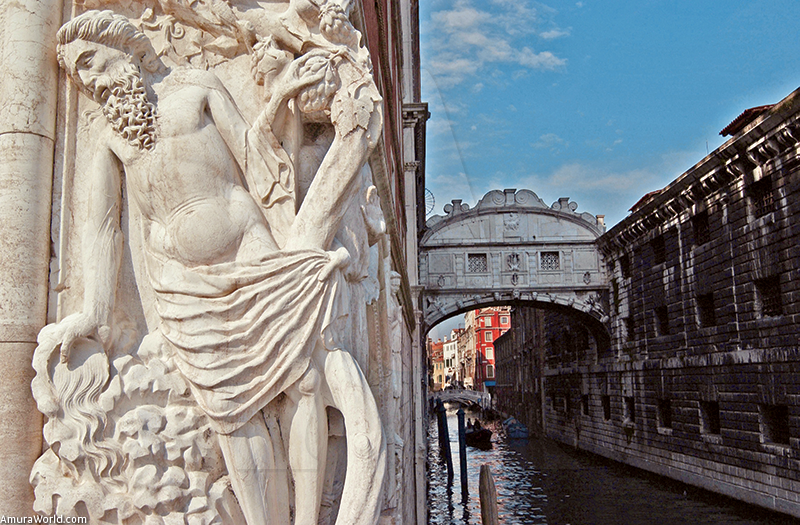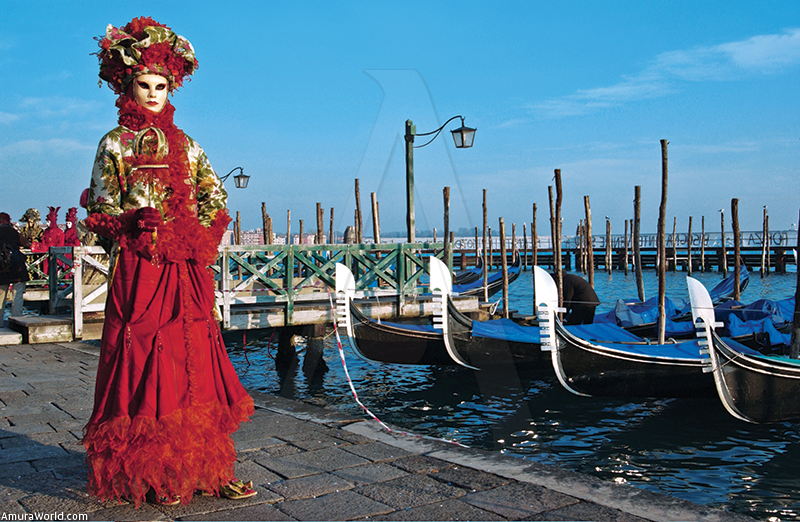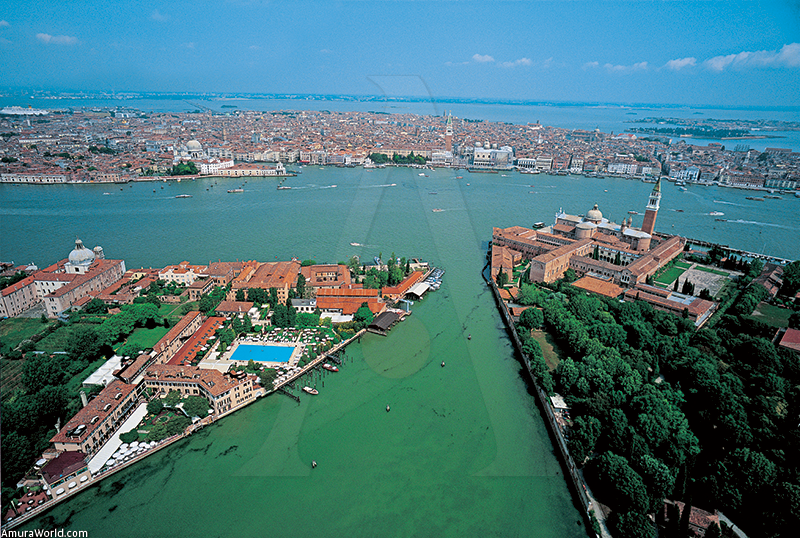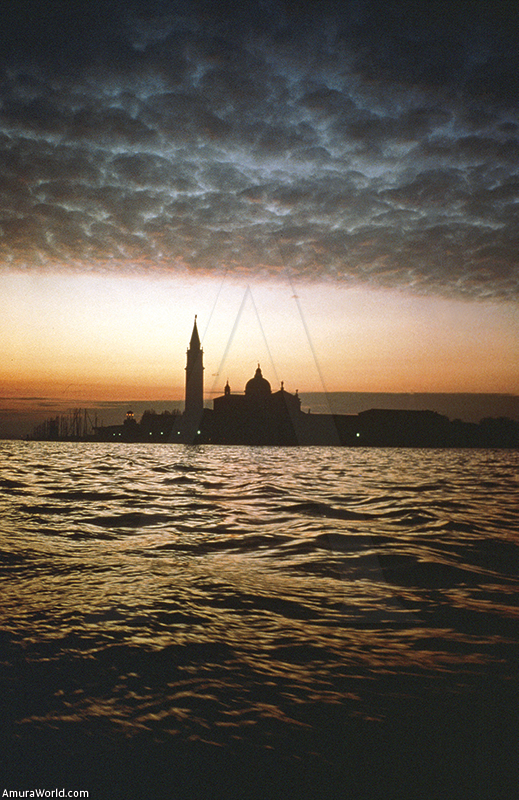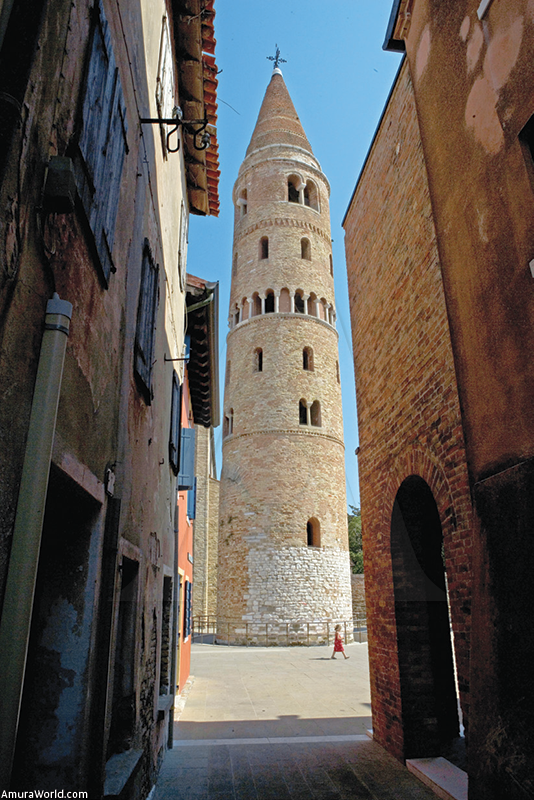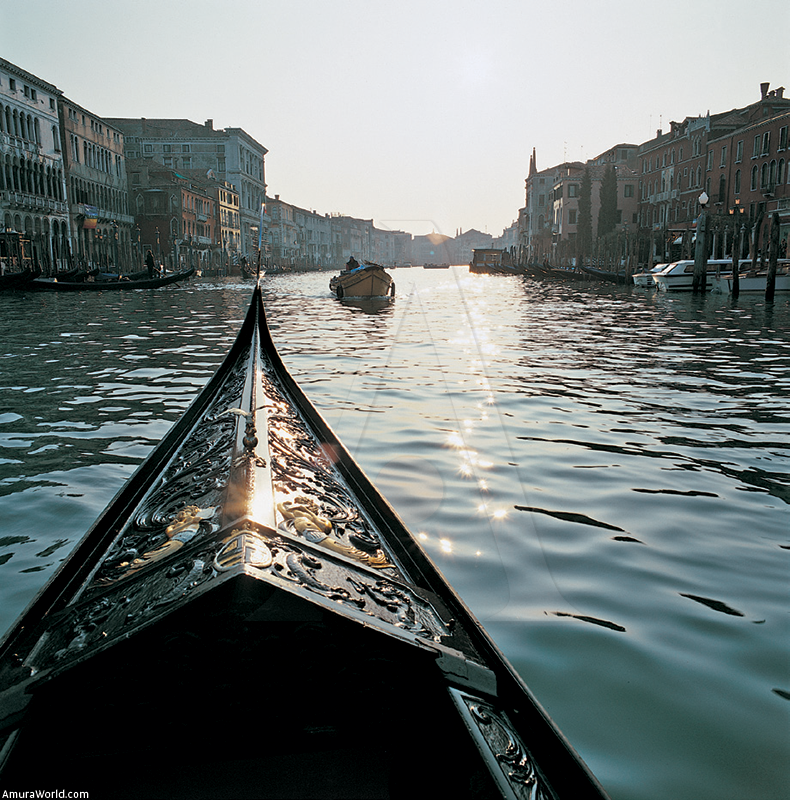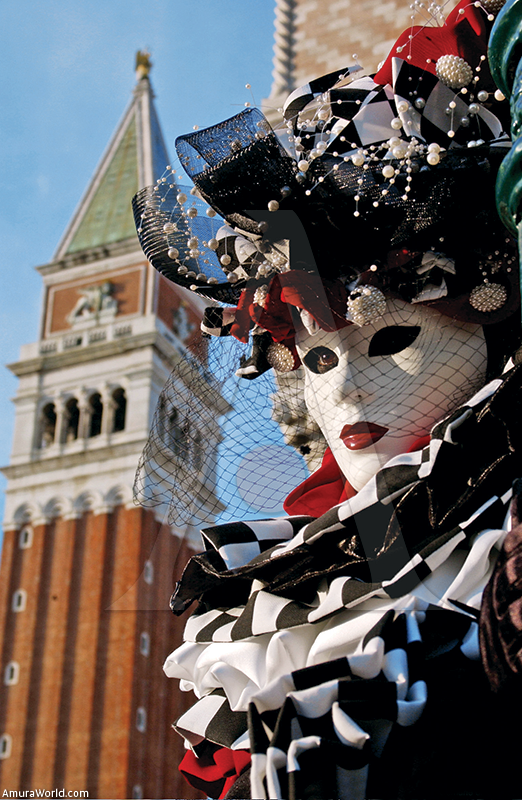The City of the Canals is the capital of the Veneto region. It is located among a group of islands that reach a homonymous swampy lagoon in the Adriatic Sea, among the mouth of the rivers Po (south), and Piave (north), and at the northeast of Italy.
Venice is made by 120 small islands united among themselves by 400 bridges. You can reach Venice by land through the Liberty Bridge which gives access to the Piazzale of Rome.
The main urban core solidified in the Rivo Alto (Rialto) area, where at the beginning of the IX century the body of Saint Mark the evangelist (which symbolizes the winged lion) and who would be patron of the city, was moved from Alexandria.
In the following centuries, Venice grew economically, politically and demographically. Its commercial vocation was shown during the age of the crusades and in the relations with Constantinople.
Its territory was expanded, reaching a climax of glory in the XV century as a result of its expansion and triumphs in the maritime field. The Adriartic was then the Venetian sea, whose power reached even the furthest lands like Chipre.
With the discovery of America the Mediterranean trade wanes; the venetians slowly retreat before the Turkish, even though they will yet achieve success in Lepanto, allied to the Spanish ships.
The Bellini, Giorgione, Tintoretto, Tiziano and Verones are the names associated to the artistic glory of Venice, already in times of political declension. In 1797 the Venetian Republic died. Its end came by the hand of Napoleon Bonaparte.
Today Venice is still an art referent, romanticism, loved by the intellectuals that see in it the mystery of power and decadence. The high waters, often invade the city, apparently predicting that tragic fortune.
There is a project for the use of docks to regulate the flood problems. Maybe its only a dream-due to the proverbial inefficiency of the administrative Italian projects- we hope that dream comes before global warming worsens the ocean voracity and takes with it this living legend.
Birthplace of Art and Music
Venice enjoys a legendary fame because of its wide range of artistic heritage and long history as a reference for European painting.
The wealth of the city’s powerfull (the church, politicians and certain merchants) allowed to maintain a long sponsorship over painters, architects and other artists, from Gentile Bellini to Francesco Guardi, throughout many great artists.
Curiously, many of these artists had been born elsewhere and came to Venice drawn by its vigor.
The style of the following Venice painters kept some main characteristics (warm and rich color) which spread their influence around half of Europe. The so called “Venetian School” influenced very diverse teachers like Rubens and Velázquez and shaped in most part the baroque style of the XVII century.
The architecture of the city went through an especially bright period during the Renaissance, with such architects like Mauro Codussi, Pietro Lombardo, and Jacopo Sansovino, who built the monumental Marcian Library.
Antonio Vivaldi was born in Venice, one of the summits of baroque music. Another great one’s of the music, Richard Wagner, passed away in the city on February 13 of 1883. Likewise the great composer Igor Stravinski even though he died in New York, wanted his remains to be taken to Venice and today rest in the “Saint Michelle” cemetery.
All of this is a reflection of the importance of the city not only as a place of origin for many geniuses, but most of all as an endless source of inspiration throughout the history of poets, musicians, pain-ters and all type of artists.
Since 1983 it holds the Bienal of Venice, which includes the annual film festival “Mostra Internazionale d’Arte Cinematográfica”.
One of the most famous opera houses in the world is found in Venice, the La Fenice Theater, which literally means the “Fenix bird” and honors its name, having emerged from the ashes after several fires at the end of the XX century. It was a place of premiers for some of the most famous pieces of the repertuar, among them several of Verdi.
Venice Carnival
The most popular party of Venice is the Carnival whose tradition goes back to the XI century when Venice began to dominate important parts of the Mediterranean Sea. Officially it was declared as a supreme festivity during the XII century.
Nevertheless, it is in the XVIII century when the Venice Carnival reaches its climax. To it, aristocrats and travelers from all of Europe would attend in search of fun and pleasure.
With Venice decadence as a merchant and military power, the carnival faded almost to the point of disappearing.
It recovered some of its festivity when the city is overwhelmed by the invasion of thousands of tourists, although the grand periods of unlimited fun were left behind.
The great cultural tradition of Venice, summary of its millenary history, was acknowledged in 1987 by the UNESCO as a world’s heritage for the history old quarter of the city and the lagoon.
For its Alleys and Buildings
Due to all this history the best way to visit and know Venice is by foot, discovering each and every detail, alleys and brimming buildings of history of a romantic, classic and artistic Europe. And we must begin at the Great Canal which is a big moist avenue, 30 to 80 meters wide, in whose environment churches and palaces are lined up, in a surprising filled with beauty succession.
If we start in the station’s surroundings, the first thing we will see is the Bridge of the barefoot. At the left there is a beautiful cover of the church of the Barefoot Carmels, very harmonius, from the XVII century, in front the Saint Simeón Piccolo is found, of somewhat latter classicists lines.
Some 300 meters ahead, at the left, the Saint Geremia church from the XVIII century is found. At its side, in the canal which emerges from the same corner the Palace Labia from the XVII century is located with Tiepolo paintings.
At just 300 meters ahead, at the right edge, the Natural History Museum, in the Fontego dei Turchi building originated in the XIII century but rebuilt in XIX. In front the Saint Marcuola church.
From here and up to the Rialto bridge there is a high number of interesting buildings. On the left border, the Vendramin-Calergi Palace, the last residence of Richard Wagner, work of the XVI century and further ahead the Ca’d’Oro maybe the most beautiful palaciega house (besides the Ducal Palace) of a gothic venetian style, work of the XV century.
On this stretch, on the right edging, it is found among others Ca’Pesaro, baroque and from the XVII century; Brandolin Palace, gothic from the XV century; the Fabriche Nuova and the Vecchia de Rialto both from the XVI century.
El Great Canal
The Great Canal, besides the others mentioned, has a lot of appeal that one can discover little by little.
Now is time to know the most visited place in Venice the so called “Heart of the city”, of 80 meters wide and 170 long, although in an irregular shape, it was the door to the nearby Saint Zacarías convent transformed into a place in the XII century.
It has a curious pavement of decorative bands and it is surrounded by a series of regal monuments: The Procuradurías, the tower and the Basilica
of Saint Mark’s.
The Basilica of Saint Mark’s
The Procuradurías were home to great government employees. Originated in the XVI and XVII century. The building at the end, Fábrica Nuova, was made out of Napoleon’s initiative and here statues of roman emperors and of Napoleon himself where placed. In it the Basilica of Saint Mark’s is found, which was built precisely to accommodate the body of Saint Mark, brought from Alexandria, and suffered several alternatives, although the actual work is basically from the XI century, with modifications from the following centuries.
The Basilica has a cupola like shape suitable of the byzantine temples and which maintains several elements of great value such as the mosaic… a great part of its riches come from the Constantinople plunders. The main façade has five doors with marble columns and mosaics, with two levels of arcades. On the upper part it has gothic finishes.
On the terrace above the main Romanic entrance, there are four horses brought in the XII century from Constantinople. In reality they are replicas since the original ones are found inside the temple.
If the venetians snatched them-with an apology of a Crusade- Napoleon also took them to Paris, although later were replaced by the Austrian.
It has a Greek cross look, with five cupules and an interior filled with works of art that not only reflect the work of great Italian artists but -above all- the result of the venetian robbery throughout all the Mediterranean.
There are materials brought from Constantinople, of Saint John’s of Acre, from Syria, from Egypt. Even a granite block, right next to the altar, brought from Tiro, since it was tradition for in it Christ spoke. Hundreds of beautiful columns, magnificent mosaics, jewelry like the “gold shovel”, jewel from the byzantine venetian work with very valuable enamels.
Saint Giorgio Maggiore and Giudecca
From the Saint Marks Venice surroundings, two islands towards the south are seen, separated both by the historical center by the Giudecca Canal. The islands are Saint Giorgio Maggiore and Giudecca.
The Giudecca is like an oasis of tranquility in front of the lively Venice. It used to be a Jewish neighborhood -there its name- where in 1576
Palladio built a magnificent Church, of the Redeeming, as an offering to request an evil plague.
Like in many Venice churches, the artistic treasures are abundant, specially pictorial ones. Here you will find the work of Francesco Bassano, Palma the young, and of Verones and Tintoretto disciples.
The party of the redeemer, in July, is one of the biggest in the area. For this period Venice is united with the Giudecca, through a floating bridge that crosses the Giudecca Canal.
The Academy Museum
At the edge of the Great Canal, not too far away from its point of encounter with the Giudecca on of the most important museums of Italy is found: The Academy.
The interest of this center, found in the Saint Mary’s della Caritá church and the dei Canonici Lateranensi convent, work of Palladio, is a magnificent place to submerge in the venetian painting, from the primitives ahead, specially the Renaissance.
Venice has one of the most prestigious schools of painting in Italy, and in the Academy Galleries collections of paintings from the Venetian school of the middle ages up to the Renaissance are kept with masterpieces of Bellini, Tiziano, Giorgione, Tintoretto, Veronés, Canaleto, Longhi and
a long etcetera.
Next to the Saint Mark’s Basilica of Venice a splendid bell tower is found, of pure lines, practically
100 meters high.
The bell tower was originally from the XI century , but suffered several mishaps, among them a fire in the XV century and the well known foundation problems among the lagoons ground… ¿the consequence? The work today is from the beginning of the XX century.
The red tone of the brick, the White of the Istria Stone and the green of the copper of the roof make all together a simple and attractive whole, heighten by its straight lines.
It has at its foot a beautiful logia, the Loggetta, from the XVI century. It was used long ago to accommodate the body of Guardia, during the Great Council sessions. It is the work of Sansovino, author also of the great Vecchia library nearby.
Murano and Burano Islands
Lo mejor de todo, la posibilidad de subir allá arriba y contemplar la laguna veneciana, las islas, y al fondo, el Adriático y aún las estribaciones alpinas.
Además uno puede visitar algunas islas muy interesantes que la mejor manera de hacerlo es mediante el Vaporetto, es posible acceder fácilmente a la Isla de Murano, famosa por su producción de vidrio desde el Siglo XIII. Aunque la competencia ha hecho cerrar a diversos talleres, aún quedan artesanos y es posible visitarlos. También por el mismo medio es posible visitar la Isla de Burano, donde la especialidad son los encajes y al igual que en Murano se ha visto afectada la producción pero siguen muchos talleres abiertos.
Venecia es de esos lugares que nos envuelve entre romance, historia y belleza en medio de una pequeña gran ciudad italiana.
Guggenheim Venecia
The Guggenheim museum of Venice is one of the most beautiful in town, with an ideal size for not getting tired and with a representation of the most relevant movements of Italian, European and American sculpture and painting from the first half of the 20th century.
The museum was opened in the year 1980 and shows the personal collection of Peggy Guggenheim, masterpieces for the Gianni Mattioli collection, and the sculpture garden of Nasher as well as temporary exhibitions.
This House-Museum is located in the Venier dei Leoni Palace, in the Great Canal, where Peggy lived and enjoyed the company of most of the artists that painted the pieces revealed in the galleries and even those of which she was their sponsor.
Peggy Guggenheim strolled around her friends work, Jean Arp, Vasily Kandinski, Marcel Duchamp, Pablo Picasso, Max Ernst y Jackson Pollock, through Europe and the United States, among others, without minding her Jewish condition in the middle of the Nazi´s top moment.
Peggy's Guggenheim collection is administered by the Solomon R. Guggenheim foundation, which also operates New York's Solomon R. Guggenheim, the Bilbao Museum, the Deutsche Guggenheim in Berlin and the Las Vegas Guggenheim-Hermitage.
Like in most contemporary art museums, the Guggenheim foundation offers quite a few practice scholarships and an important pedagogic role plus, the classes are not just a few, symposiums and rotations are organized under the supervision of the museum commissioners along with other important centers.
Info
Guggenheim Venecia
704 Dorsoduro, 30123
T: 0039 041 2405411
www.guggenheim-venice.it
This email address is being protected from spambots. You need JavaScript enabled to view it.
Text: Enrique Rosas ± Foto: Orient-Express Hotels, Dreamstime,Concessione del Comune di Venezia, Peggy Guggenheim

